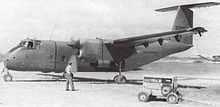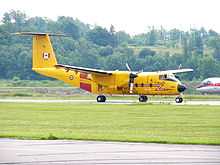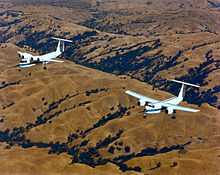De Havilland Canada DHC-5 Buffalo
The de Havilland Canada DHC-5 Buffalo is a short takeoff and landing (STOL) utility transport, a turboprop aircraft developed from the earlier piston-powered DHC-4 Caribou. The aircraft has extraordinary STOL performance and is able to take off in distances much shorter than even light aircraft can manage.
Design and development
The Buffalo arose from a 1962 United States Army requirement for a STOL transport capable of carrying the same payload as the CH-47A Chinook helicopter.[1] de Havilland Canada based its design to meet the requirement on an enlarged version of its DHC-4 Caribou, already in large-scale service with the United States Army, to be powered by General Electric T64 turboprops rather than the Pratt & Whitney R-2000 piston engines of the Caribou. (It had already flown a T-64 powered Caribou on 22 September 1961).[1]

De Havilland's design, the DHC-5 Buffalo, was chosen as the winner of the United States Army competition in early 1963, with four DHC-5s, designated YAC-2 (later CV-7A and subsequently C-8A) ordered.[2] The first of these aircraft made its maiden flight on on 9 April 1964.[3] All four aircraft were delivered in 1965, the Buffalo carrying nearly twice the payload as the Caribou while having better STOL performance. The prototype CV-7A was exhibited by the manufacturer at the 1965 Paris Air Show wearing US Army markings. No further US orders followed, however, as at the start of 1967, inter-service politics lead to large fixed-wing transports being transferred to the United States Air Force,[2] who considered themselves adequately equipped with the Fairchild Aircraft C-123 Provider.
Company data claims a takeoff distance over a 50 ft (15 m) obstacle of 1,210 ft (369 m) at 41,000 lb (18,597 kg) and a landing distance of over a 50 ft (15 m) obstacle of 980 ft (299 m) at 39,100 lb (17,735 kg) for the DHC-5A model.[4]
In the early 1980s, de Havilland Canada attempted to modify the Buffalo for civilian use. The aircraft was to be branded as the "Transporter." After loss of the demonstration aircraft (SN 103 C-GCTC) at the 1984 Farnborough Airshow, the project was abandoned.[citation needed]

A production DHC-5D Buffalo was used for breaking time-to-height records for the weight category 12,000–16,000 kg (26,430–35,242 lb) on 16 February 1976, reaching 3,000 m (9,836 ft) in 2 min 12.75 sec, 6,000 m (19,672 ft) in 4 min 27.5 sec and 9,000 m (29,508 ft) in 8 min 3.5 sec.[5]
Experimental use
In the early 1970s, a NASA C-8A Buffalo (nicknamed Bisontennial in 1976) was fitted with a short-span Boeing wing incorporating split-flow turbofan engines based on the Rolls-Royce Spey (providing both propulsion and augmentor airflow for the powered lift system).[6][7][8][9] Beginning in 1972 with its first flight in this experimental configuration, this aircraft was used jointly by the NASA Ames Research Center and the Canadian Department of Industry, Trade and Commerce for STOL research.[8][10]

In the late 1970s and early 1980s, NASA used another C-8A Buffalo in the Quiet Short-Haul Research Aircraft (QSRA) program.[6][7][11]:153[12][13][14]
Its experimental wing was designed, fabricated and installed by Boeing, and was a swept, supercritical design incorporating a boundary layer control system.[12][13]:8 Instead of the standard engines, this aircraft was powered by four prototype Avco Lycoming YF102 high-bypass turbofan engines (originally from the Northrop YA-9 program) mounted above the wing to take advantage of the Coandă effect.[13]:9–10 In 1980, this aircraft participated in carrier trials aboard USS Kitty Hawk, demonstrating STOL performance without the use of catapults or arrestor gear.[7][11]:154
New production
On February 24, 2006, Viking Air of Victoria, British Columbia, a manufacturer of replacement parts for all out-of-production de Havilland Canada aircraft, purchased the type certificates from Bombardier Aerospace for all versions of the DHC-1 through DHC-7 series aircraft, giving Viking exclusive rights to manufacture and sell new aircraft of those types. In December 2008, Viking Air indicated their intention to put the Buffalo series back into production at their home factory in Victoria, British Columbia or in Calgary, Alberta. The new production Buffalo features Pratt & Whitney Canada PW150 turboprops, a glass cockpit, enhanced vision and night vision goggle capability. The company intends to propose the aircraft as a replacement for the Royal Canadian Air Force fleet of existing DHC-5As,[15] and says it has received extensive interest in the type, including several letters of intent for the DHC-5NG.[16]
Operational history

In late 1965, one of the prototype DHC-5s operated by the U.S. Army was deployed to Bien Hoa Air Base in South Vietnam for a three-month evaluation period, assigned to the 2nd Flight Platoon of the 92nd Aviation Company.[17]
The Royal Canadian Air Force (merged into the Canadian Forces in 1968) first acquired 15 DHC-5A designated as CC-115 for tactical transports. These were initially operated at CFB St Hubert, QC by No. 429 Squadron in a tactical aviation role as part of Mobile Command. In 1970, the Buffalo aircraft were transferred to a transport and rescue role with No. 442 Squadron, No. 413 Squadron and No. 424 Squadron as part of Transport Command. No. 426 Squadron also flew the aircraft for training. Some were leased back or loaned back to the factory for trials and eventually returned to military service.
Three of the aircraft were also deployed on UN missions to the Middle East with No. 116 Transport Unit until 1979. They had a white paint scheme which was retained while they were serving in domestic transport with 424 Sqn in between deployments. On 9 August 1974, Canadian Forces CC-115 Buffalo 115461 was shot down by a Syrian surface-to-air missile, killing all nine CF personnel on board. This represents the single biggest loss of Canadian lives on a UN mission as well as the most recent Canadian military aircraft to be shot down.
In 1975, the Buffalo dropped its tactical transport role and was converted to domestic search and rescue, except for a few that kept serving on UN missions. The initial paint scheme for the SAR converted aircraft were white and red while others still had the original drab paint. The previous drab paint and white paint were eventually replaced with the distinctive yellow and red scheme commonly seen today. The number of aircraft have been reduced to eight, with six on active service, one in storage (recently dismantled) and one used for battle damage training. The remaining operational Buffalos operate in the Search and Rescue role for No. 442 Squadron at CFB Comox. Air Command was renamed the Royal Canadian Air Force in 2011, meaning the CC-115 has served with the RCAF, Air Command and now the RCAF once again. The Buffalo was replaced by the CC-130 Hercules aircraft at search-and-rescue bases in CFB Greenwood and CFB Trenton. The EADS CASA C-295 or Alenia C-27J Spartan were seen as the likely replacements for the Buffalo in Canadian Forces. The C-27J has been considered for a sole-source contract by the Government of Canada.[18]
Production of the DHC-5A ended in 1972 after sales to Brazil and Peru but restarted with the DHC-5D model in 1974. This variant sold to several overseas air forces beginning with Egypt.
There are currently two Buffalo aircraft used commercially in Canada. They are operated by Arctic Sunwest Charters, Yellowknife, Northwest Territories.[19]
Variants


- DHC-5 Buffalo
- Originally designed as a twin-engined STOL tactical, utility transport aircraft for the US Army. Original US Army designation AC-2.
- DHC-5A
- Utility transport aircraft for the Brazilian Air Force, Royal Canadian Air Force and Peruvian Air Force. Canadian designation CC-115.
- DHC-5B
- Proposed version, powered by two General-Electric CT64-P4C turboprop engines. Not built.
- DHC-5C
- Proposed version, powered by two Rolls-Royce Dart RDa.12 turboprop engines. Not built.
- DHC-5D
- Improved version, powered by two 2,336 kW (3,133 shp) General Electric CT64-820-4 turboprop engines.
- DHC-5E Transporter
- Civil transport version.
- NASA / DITC C-8A
- One C-8A aircraft converted into an augmentor wing research aircraft.
- XC8A ACLS
- One C-8A aircraft converted into an air-cushion landing system research aircraft.
- NASA / Boeing QSRA C-8A
- One C-8A converted into a quiet short-haul research aircraft.
- Viking DHC-5NG Buffalo NG
- Proposed redesigned new production version to be built by Viking Air. NG is the company marketing term indicating Next Generation[20][21]
Canadian military designations
- CC-115
- Canadian military designation for 15 DHC-5As.

United States military designations
- AC-2
- Designation for four DHC-5s for evaluation by the United States Army.
- CV-7A
- Re-designation of four United States Army AC-2s.
- C-8A
- United States Air Force designation for four CV-7As transferred from the Army in 1967.
Operators
Civil
- Arctic Sunwest Charters (171817 Canada Inc)[19]
Military

- Abu Dhabi Defence Forces Air Wing – Former operator.[23]
- United Arab Emirates Air Force
- Brazilian Air Force (Retired)
- Chilean Air Force (Retired)
 Democratic Republic of the Congo (previously
Democratic Republic of the Congo (previously  Zaire)
Zaire)
- Indonesian Air Force (Retired)
- Mauritanian Air Force
- Royal Oman Police Air Wing
- Peruvian Air Force (Retired)
- Military of Tanzania
Accidents and incidents
In total, 26 hull losses have been recorded. The most notable crash involving a DHC-5 occurred on 27 April 1993, when a DHC-5 carrying the Zambia national football team to a 1994 FIFA World Cup qualifier against Senegal crashed shortly after takeoff from a refuelling stop in Libreville, Gabon. All 30 people on board perished.[25]
- On 9 August 1974, a Canadian Forces CC-115 operating for the United Nations was shot down over Syria with the loss of five crew and four passengers.[26]
- At the 1984 Farnborough Airshow, a DHC-5D STOL demonstration ended in a very heavy landing which destroyed the aircraft.[27][28]
- On 21 June 1989, a Peruvian Air Force DHC-5 crashed into a mountain near Tarma, killing all six crew and 53 passengers.[29]
Specifications (DHC-5D)
Data from Jane's All The World's Aircraft 1982–83 [30]
General characteristics
- Crew: Three (pilot, co-pilot and crew chief)
- Capacity: 41 troops or 24 stretchers
- Payload: 18,000 lb (8,164 kg))
- Length: 79 ft 0 in (24.08 m)
- Wingspan: 96 ft 0 in (29.26 m)
- Height: 28 ft 8 in (8.73 m)
- Wing area: 945 sq ft (87.8 m²)
- Airfoil: NACA 643A417.5 (mod) at root, NACA 632A615
- Empty weight: 25,160 lb (11,412 kg)
- Max. takeoff weight: 49,200 lb (22,316 kg)
- Powerplant: 2 × General Electric CT64-820-4 turboprop, 3,133 hp (2,336 kW) each
Performance
- Maximum speed: 290 mph (252 knots, 467 km/h) at 10,000 ft (3,050 m)
- Stall speed: 77 mph (67 knots, 124 km/h)
- Range: 691 miles (600 nmi, 1,112 km)at 10,000 ft (3,050 m) (max payload)
- Service ceiling: 31,000 ft (9,450 m)
- Rate of climb: 2,330 ft/min (11.8 m/s)
See also
- Related development
- Aircraft of comparable role, configuration and era
- Antonov An-32
- CASA CN-235
- Alenia G.222
- Transall C-160
- EADS CASA C-295
- Related lists
- List of active Canadian military aircraft
References
- Notes
- ↑ 1.0 1.1 Air International August 1976, p. 59.
- ↑ 2.0 2.1 Harding 1990, p. 104.
- ↑ Air International August 1976, p. 70.
- ↑ de Havilland Canada: DHC-5A Buffalo STOL Tactical Transport, page 6. de Havilland Canada, May 1971
- ↑ Air International August 1976, p. 64.
- ↑ 6.0 6.1 Baugher, Joseph F. "1963 USAF Serial Numbers." USAAS-USAAC-USAAF-USAF Aircraft Serial Numbers—1908 to Present, 2008. Retrieved: 13 September 2009.
- ↑ 7.0 7.1 7.2 Buser, Wayne E. "NASA Buffalos." The deHavilland Caribou (DHC-4) and Buffalo (DHC-5) Website, 2006. Retrieved: 13 September 2009.
- ↑ 8.0 8.1 "First Augmentor Wing Aircraft Flight." The Astrogram, Volume XIV, Issue 16, 11 May 2005, pp. 1–2. Retrieved: 13 September 2009.
- ↑ "N716NA." Airliners.net, Aviation Photos. Retrieved: 13 September 2009.
- ↑ "STOL Buffalo Flies." Flight International, Volume 101, Issue 3295, p. 658. Retrieved: 13 September 2009.
- ↑ 11.0 11.1 Norton, Bill. STOL Progenitors: The Technology Path to a Large STOL Transport and the C-17A. Reston, VA: AIAA, 2002. ISBN 978-1-56347-576-4.
- ↑ 12.0 12.1 "CV-7 / C-8A Buffalo / DHC-5." GlobalSecurity.org. Retrieved: 13 September 2009.
- ↑ 13.0 13.1 13.2 Shovlin, Michael D. and John A. Cochrane. "An Overview of the Quiet Short-Haul Research Aircraft Program." nasa.gov, 1978. Retrieved: 13 September 2009.
- ↑ "N715NA." Airliners.net, Aviation Photos. Retrieved: 13 September 2009.
- ↑ Niles, Russ. "Viking Proposes Resurrection Of DHC-5 Buffalo." avweb.com, December 2008. Retrieved: 13 September 2009.
- ↑ Sarsfield, Kate (12 July 2012). "FARNBOROUGH: Viking evaluates market for DHC-5 Buffalo relaunch". FlightGlobal. Retrieved 2013-03-30.
- ↑ "De Havilland (DHC-5) Buffalo, Page 2". de Havilland Caribou (DHC-4) and Buffalo (DHC-5) web site. Retrieved: 3 May 2010.
- ↑ "Report: DND to look at single bid for search planes." cbc.ca, 3 January 2007. Retrieved: 13 September 2009.
- ↑ 19.0 19.1 Canadian Civil Aircraft Register. Search using "DHC-5" in the "Model Name:" box.
- ↑ "DHC-5NG Buffalo versus C-27J Spartan." Viking Air, January 2009. Retrieved: 13 September 2009.
- ↑ "Buffalo NG News." Viking Air, January 2009. Retrieved: 13 September 2009.
- ↑ Rohde, Andreas. "Riding a Buffalo – with Arctic Sunwest Charters." Airways, Volume 15, No. 12, Issue 156, February 2009, pp. 30–35. ISSN 1074-4320. Note: Only two of the 126 Buffalos built were for a commercial operator – Ethiopian Airlines.
- ↑ Buffalo roster, DHC4and5.org
- ↑ Canadian Forces Air Command – CC-115 – Overview and Canadian Forces Air Command – CC-115 – Technical Specifications
- ↑ "Team Crashes." Flight International, Volume 143, Issue 4368, 11 May 1993, p. 13. Retrieved: 13 September 2009.
- ↑ "de Havilland Canada CC-115 Buffalo 115461." aviation-safety.net. Retrieved: 13 September 2009.
- ↑ Accident description – Aviation Safety Network
- ↑ deHavilland DHC-5 Buffalo Crash – video of accident
- ↑ Accident description – Aviation Safety Network
- ↑ Taylor 1982, pp. 25–26.
- Bibliography
- "DHC-5D ...A Beefier Buffalo." Air International, Volume 11, Number 2, August 1976, pp. 59–67. Bromley, UK: Fine Scroll.
- Harding, Stephen. U.S. Army Aircraft Since 1947. Shrewsbury, UK: Airlife, 1990. ISBN 1-85310-102-8.
- Hotson, Fred W. The de Havilland Canada Story. Toronto: CANAV Books, 1983. ISBN 0-07-549483-3.
- Milberry, Larry. Aviation In Canada. Toronto: McGraw-Hill Ryerson Ltd., 1979. ISBN 0-07-082778-8.
- Molson, Ken M. and Harold A. Taylor. Canadian Aircraft Since 1909. Stittsville, Ontario: Canada's Wings, Inc., 1982. ISBN 0-920002-11-0.
- Taylor, John W.R. Jane's All The World's Aircraft 1982–83. London:Jane's Yearbooks, 1982. ISBN 0-7106-0748-2.
External links
| Wikimedia Commons has media related to De Havilland Canada DHC-5 Buffalo. |
- Royal Canadian Air Force CC-115 Buffalo website
- Viking Air – current DHC-5 certificate holder and planned manufacturer
- Diagrams of the DHC-5D
| |||||
| ||||||||||||||
| |||||||||||
| ||||||||
| ||||||||||||||